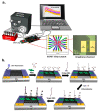Influence of the Electrolyte Salt Concentration on DNA Detection with Graphene Transistors
- PMID: 33477344
- PMCID: PMC7830926
- DOI: 10.3390/bios11010024
Influence of the Electrolyte Salt Concentration on DNA Detection with Graphene Transistors
Abstract
Liquid-gated Graphene Field-Effect Transistors (GFET) are ultrasensitive bio-detection platforms carrying out the graphene's exceptional intrinsic functionalities. Buffer and dilution factor are prevalent strategies towards the optimum performance of the GFETs. However, beyond the Debye length (λD), the role of the graphene-electrolytes' ionic species interactions on the DNA behavior at the nanoscale interface is complicated. We studied the characteristics of the GFETs under different ionic strength, pH, and electrolyte type, e.g., phosphate buffer (PB), and phosphate buffer saline (PBS), in an automatic portable built-in system. The electrostatic gating and charge transfer phenomena were inferred from the field-effect measurements of the Dirac point position in single-layer graphene (SLG) transistors transfer curves. Results denote that λD is not the main factor governing the effective nanoscale screening environment. We observed that the longer λD was not the determining characteristic for sensitivity increment and limit of detection (LoD) as demonstrated by different types and ionic strengths of measuring buffers. In the DNA hybridization study, our findings show the role of the additional salts present in PBS, as compared to PB, in increasing graphene electron mobility, electrostatic shielding, intermolecular forces and DNA adsorption kinetics leading to an improved sensitivity.
Keywords: DNA; Debye length; graphene; liquid gate; phosphate buffer (PB); phosphate buffer saline (PBS); salts.
Conflict of interest statement
The authors declare no conflict of interest.
Figures






Similar articles
-
Electrolyte-Gated Graphene Ambipolar Frequency Multipliers for Biochemical Sensing.Nano Lett. 2016 Apr 13;16(4):2295-300. doi: 10.1021/acs.nanolett.5b04729. Epub 2016 Mar 3. Nano Lett. 2016. PMID: 26928906
-
Scalable Production of High-Sensitivity, Label-Free DNA Biosensors Based on Back-Gated Graphene Field Effect Transistors.ACS Nano. 2016 Sep 27;10(9):8700-4. doi: 10.1021/acsnano.6b04110. Epub 2016 Sep 2. ACS Nano. 2016. PMID: 27532480 Free PMC article.
-
Three dimensional graphene transistor for ultra-sensitive pH sensing directly in biological media.Anal Chim Acta. 2016 Aug 31;934:212-7. doi: 10.1016/j.aca.2016.05.048. Epub 2016 Jun 21. Anal Chim Acta. 2016. PMID: 27506362
-
Graphene field-effect transistors as bioanalytical sensors: design, operation and performance.Analyst. 2021 Jan 21;146(2):403-428. doi: 10.1039/d0an01661f. Epub 2020 Nov 20. Analyst. 2021. PMID: 33215184 Review.
-
Interactions of DNA with graphene and sensing applications of graphene field-effect transistor devices: a review.Anal Chim Acta. 2015 Jan 1;853:127-142. doi: 10.1016/j.aca.2014.10.023. Epub 2014 Oct 18. Anal Chim Acta. 2015. PMID: 25467454 Review.
Cited by
-
Rapid, Selective, and Ultra-Sensitive Field Effect Transistor-Based Detection of Escherichia coli.Materials (Basel). 2024 Jul 24;17(15):3648. doi: 10.3390/ma17153648. Materials (Basel). 2024. PMID: 39124311 Free PMC article.
-
Electronic Sensing Platform (ESP) Based on Open-Gate Junction Field-Effect Transistor (OG-JFET) for Life Science Applications: Design, Modeling and Experimental Results.Sensors (Basel). 2021 Nov 11;21(22):7491. doi: 10.3390/s21227491. Sensors (Basel). 2021. PMID: 34833566 Free PMC article.
-
Interplay of graphene-DNA interactions: Unveiling sensing potential of graphene materials.Appl Phys Rev. 2024 Mar;11(1):011306. doi: 10.1063/5.0171364. Epub 2024 Jan 26. Appl Phys Rev. 2024. PMID: 38784221 Free PMC article.
-
Integrated Approach from Sample-to-Answer for Grapevine Varietal Identification on a Portable Graphene Sensor Chip.ACS Sens. 2023 Feb 24;8(2):640-654. doi: 10.1021/acssensors.2c02090. Epub 2023 Jan 19. ACS Sens. 2023. PMID: 36657739 Free PMC article.
-
Diagnostics of Tuberculosis with Single-Walled Carbon Nanotube-Based Field-Effect Transistors.ACS Sens. 2024 Apr 26;9(4):1957-1966. doi: 10.1021/acssensors.3c02694. Epub 2024 Mar 14. ACS Sens. 2024. PMID: 38484361 Free PMC article.
References
-
- Neto A.H.C., Guinea F., Peres N.M.R., Novoselov K.S., Geim A.K. The electronic properties of grapheme. Rev. Mod. Phys. 2009;81:109. doi: 10.1103/RevModPhys.81.109. - DOI
-
- Yang Y., Asiri A.M., Tang Z., Du D., Lin Y. Graphene based materials for biomedical applications. Mater. Today. 2013;16:365–373. doi: 10.1016/j.mattod.2013.09.004. - DOI
-
- Chu C.-H., Sarangadharan I., Regmi A., Chen Y.-W., Hsu C.-P., Chang W.-H., Lee G.-Y., Chyi J.-I., Chen C.-C., Shiesh S.-C., et al. Beyond the Debye length in high ionic strength solution: Direct protein detection with field-effect transistors (FETs) in human serum. Sci. Rep. 2017;7:1–15. doi: 10.1038/s41598-017-05426-6. - DOI - PMC - PubMed
MeSH terms
Substances
Grants and funding
LinkOut - more resources
Full Text Sources
Other Literature Sources

